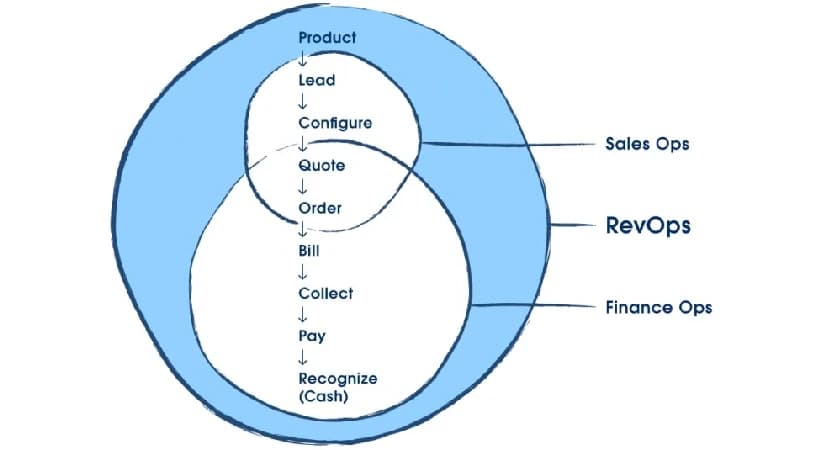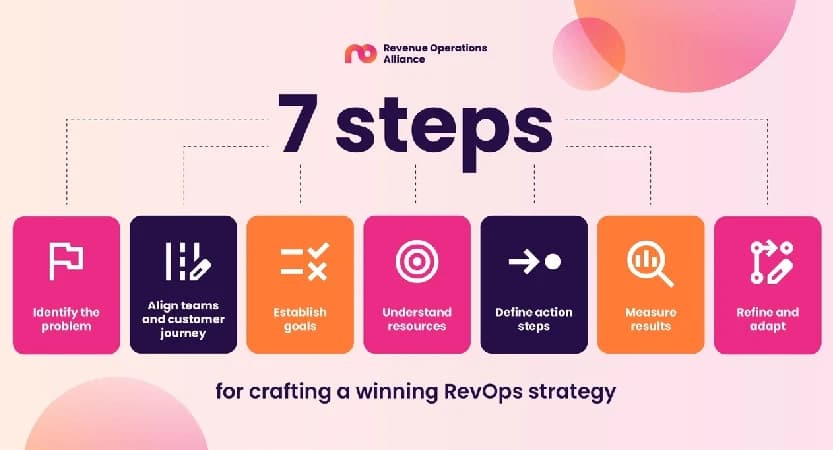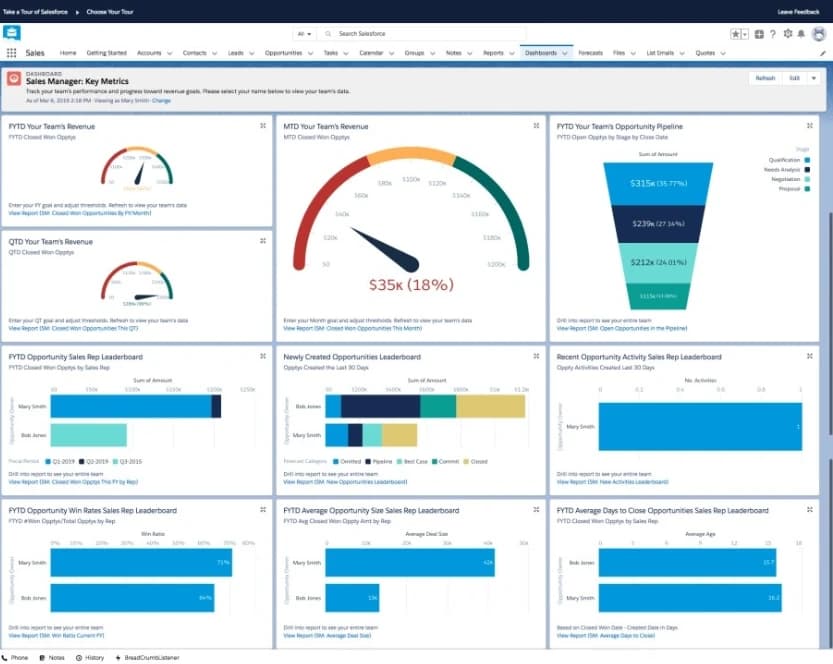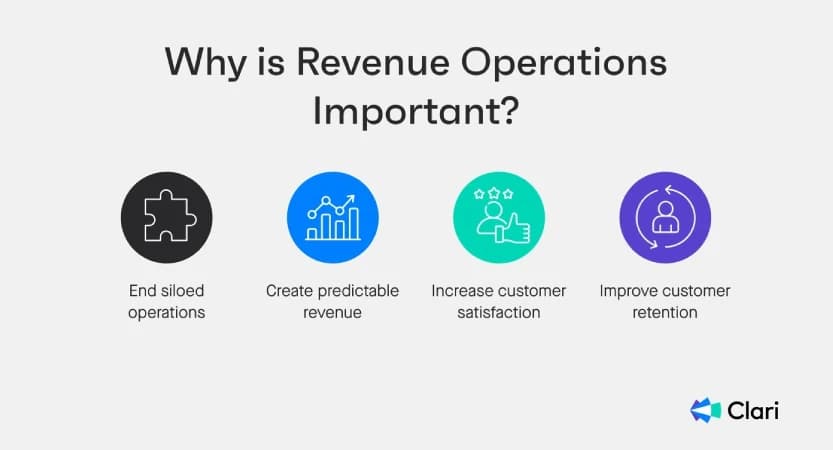The numbers tell an interesting story about RevOps' impact. "" in 2023 came from RevOps, surpassing all other functions. RevOps stepped up to fix scattered go-to-market efforts. The main goal focuses on streamlining sales, marketing, and customer success to improve efficiency, deliver better customer experiences, and build lasting revenue growth. 48% of new business AI use cases
In this piece, we'll dive into RevOps' meaning, strategies, metrics, and AI's role in reshaping the scene of revenue operations. Let's start by looking at RevOps' evolution and why modern businesses need it to optimize their revenue lifecycle.
The Evolution of RevOps

Image Source: Salesforce
The business world has transformed dramatically in the last two decades. Back in the early 2000s, organizations kept their marketing, sales, and customer success departments separate. Each department worked independently with its own goals, metrics, and reporting systems. This fragmented approach created major operational challenges that modern businesses had to overcome.
AI and Automation in RevOps

Image Source: Forbes
AI reshapes the revenue operations scene, giving businesses new ways to streamline processes and stimulate growth. Modern RevOps strategies now use AI-powered solutions as manual workflows and disconnected systems fade away.
- How AI is transforming RevOps
Revenue operations used to depend on manual processes and disconnected systems to handle sales, marketing, and customer success. This created data silos, inefficiencies, and misalignment between departments. Technology advances have now pushed RevOps into a new phase of effectiveness.
AI-powered analytics tools process huge amounts of data quickly and give actionable insights. Organizations can make data-driven decisions, spot trends, and predict outcomes more accurately. Companies learn more about customer behavior, sales performance, and market dynamics through AI-driven analytics. This helps them fine-tune strategies and create individual-specific experiences.
Sales processes have changed dramatically with AI tools that automate routine tasks like lead scoring, email follow-ups, and pipeline management. Machine learning algorithms help identify and prioritize high-potential leads so sales teams can focus on prospects most likely to convert. The system also spots cross-selling and upselling chances, suggests best actions at each sales stage, and delivers real-time performance analytics.
Customer relationship management works differently now. AI-equipped CRM systems analyze customer interactions across touchpoints and provide detailed views of customer experiences. Companies can create individual-specific experiences, predict needs, and build stronger relationships. These systems also handle customer support through chatbots and virtual assistants that respond quickly to questions.
- Agentic systems and RevOps automation
AI in RevOps has reached a key milestone with agentic AI systems. Unlike traditional automation needing explicit instructions, agentic AI works more independently—it perceives, interprets, and reasons with data before completing tasks on its own.
Agentic AI goes far beyond traditional automation and predictive analytics. These systems can set goals, pick tools, and finish multi-step workflows with minimal human oversight. The real value of agentic AI in RevOps comes from its ability to change from reactive to proactive management of customer relationships.
Lead management works better with agentic AI as teams can focus on high-value leads using real-time insights. Dynamic machine learning models score leads based on website activity, email engagement, and third-party intent data. The system qualifies leads automatically, enriches CRM records, and picks the best sales representative for each lead based on territory, expertise, and past success.
Companies using agentic systems show remarkable results. Organizations using HubSpot's AI capabilities have achieved a from Marketing Qualified Leads to Sales Qualified Opportunities. Mintel used Gong's conversation analytics to boost win rates by 34%.
35% conversion rateZapier combines AI with RevOps automation to turn campaign data, leads, and support tickets into instant insights. Teams work better, processes run smoothly, and customers have better experiences. A customer said, "Automating our customer acquisition flow impacted our customers because now they're able to support their international customers quicker... our time to value has shrunk by over 40%".
- Benefits of AI-driven RevOps
Companies that use AI-driven RevOps strategies see many advantages that boost their bottom line. These benefits go beyond just efficiency gains to fundamental improvements in revenue generation and customer experience.
Key benefits include:
- Boosted productivity and efficiency: AI handles repetitive tasks like data entry and follow-ups, letting teams focus on value-driven activities. One company reported that "Zapier has allowed us to maintain a robust customer profile that allows us to personalize customer communication, diagnose customer experience issues, and helps us share learnings across the company".
- Data accuracy and insights: AI algorithms improve data quality and consistency while analyzing vast datasets to find patterns and actionable insights. Honeywell's opportunity-scoring and forecasting solutions that use platforms like Salesforce and Tableau have shown clear benefits through smooth integration.
- Better sales performance: AI helps sales teams close more deals by spotting at-risk deals and suggesting actions. A RevOps expert said their AI-powered forecasting tool is "nearly 30% more accurate to make predictions".
- Cost savings: Organizations report big cost cuts. One company noted that "Zapier contributes to an overhead savings of around USD 500,000+ on an annual basis, and it's growing every day". Another said they "would have needed over 100 employees today just to do what we're doing, which would have been unsustainable" without AI automation.
- Scalability: AI tools help operations grow efficiently as businesses expand. Companies stay ahead of market changes and tackle new challenges with confidence.
Tech Mahindra's RevOps implementation in digital business services achieved a for a large retail e-commerce client. About 94% of executives agree that AI plays a significant role in business success over the next five years. This shows how important AI has become in revenue operations.
27% increase in revenue per advertiserAI-driven RevOps has become essential to modern business strategies. This change goes beyond just adopting new technology—it shows a strategic shift that helps organizations grow steadily in competitive markets.
RevOps Strategies for Modern Teams

Image Source: Revenue Operations Alliance
Businesses today know that getting revenue-generating departments to line up is crucial for long-term growth. Teams that don't work together create friction that affects profits directly. Studies show companies with well-coordinated teams see. up to 72% higher profitability
- Getting sales, marketing, and customer success to work together
Breaking down walls between departments forms the core of successful RevOps. B2B tech companies that use RevOps see amazing results according to Boston Consulting Group. These include 100% to 200% better digital marketing ROI and 10% more accepted leads. The companies also see 20% better sales efficiency and spend 30% less on go-to-market activities.
My experience shows three strategies that really work:
Set shared goals and metrics across departments. Teams often work against each other when marketing chases leads, sales pursues revenue, and customer success focuses on retention. The solution lies in creating unified KPIs like customer lifetime value, net promoter score, churn rate, and lead-to-close conversion rates. This framework helps everyone see how their work drives revenue growth.
Use tools that aid cross-team work. Companies need central platforms where everyone can access customer data, interactions, and strategies. A RevOps leader put it well: "When everyone has access to the same insights, handoffs are smoother, and your teams are always on the same page". Platforms like HubSpot or Salesforce let teams store customer data, lead interaction notes, and marketing strategies in one place.
Build a detailed customer trip map. This visual tool shows gaps and opportunities throughout the customer's lifecycle. Input from customer-facing teams makes this map reflect real experiences. Teams can then create individual-specific responses based on behavior patterns.
- RevOps consulting and strategic planning
Many companies find RevOps hard to implement even though they know its value. So RevOps consulting has become a key resource for businesses that need expert guidance.
RevOps consultants excel in several areas:
- Strategic coordination of sales, marketing, and customer success
- Technology stack assessment and improvement
- Data integration and governance frameworks
- Process streamlining and automation opportunities
- Change management and team structure recommendations.
Forrester's research reveals that companies using a revenue operations platform grow than others. Public companies with RevOps platforms and teams show 71% better stock performance.
nearly three times fasterThe path to success starts with executive support. RevOps professionals should:
- Ask about specific department challenges and workflows
- Give brief, results-focused presentations
- Show how restructuring benefits each department
- Measure expected ROI and gradual improvements
- Share successful RevOps case studies.
After securing leadership support, teams need to define common goals and milestones for all market approaches. This planning phase combines cross-functional activities into one revenue-affecting process. It identifies productive revenue channels and sets rules for work handoffs between departments.
- RevOps strategies for sustainable growth
RevOps needs ongoing commitment to improvement and growth. Companies that embrace this approach grow 19% faster and earn 15% more profit. This explains why 75% of high-growth companies worldwide will use the RevOps model by 2025.
Long-term RevOps growth relies on three key elements:
Analytical insights drive sustainable growth decisions. Teams must define shared revenue metrics, agree on data quality standards, find ways analytics can boost revenue, and pick the right analysis methods for each case. This framework helps companies learn about trends and act proactively.
Regular improvement keeps RevOps current with business needs. Teams should review performance together, gather feedback, and try new approaches. Regular cross-department meetings help discuss strategies, share wins, and find ways to work better together.
Resilient technology infrastructure supports growth without major system changes. Companies should check if their current software supports specific revenue operations goals. The tech stack should help data flow, automate processes, and make shared work easier while adapting to changing business needs.
Gartner's studies confirm that companies with mature RevOps are twice as likely to beat revenue goals and 2.3 times more likely to exceed profit targets compared to others. This maturity creates better market alignment and integration. It ensures customer focus and smooth supplier support throughout the revenue lifecycle.
RevOps Metrics and Performance Tracking

Image Source: LinkedIn
Success in revenue operations needs more than gut feelings. RevOps teams know they must track the right metrics to achieve predictable revenue growth. rank defining and measuring metrics among their top three responsibilities. 89% of RevOps professionals
- Top RevOps KPIs to monitor
We tracked both traditional and subscription-based metrics for successful RevOps strategies. One-time sales models emphasize margin, but subscription businesses need different evaluation metrics to understand their performance.
Revenue operations experts say these metrics give analytical insights across the revenue lifecycle:
Revenue Metrics:
- Annual Recurring Revenue (ARR): 51.3% of RevOps professionals see this as their most important metric when they participate with leadership
- Customer Lifetime Value (CLV): The total revenue a customer brings during their relationship with your company
- Net Revenue Retention (NRR): Shows every change in recurring revenue, including upsells and churn
Sales Performance Metrics:
- Pipeline Velocity: Shows how fast deals move through your pipeline in terms of revenue
- Win Rate: The percentage of sales opportunities that become closed deals
- Average Deal Size: The revenue each deal brings in on average.
Marketing Effectiveness Metrics:
- Customer Acquisition Cost (CAC): What you spend to get a new customer
- Session to Contact Rate: Your content's effectiveness in visitor engagement
- Marketing-Sourced Pipeline: Your marketing efforts' contribution to sales pipeline.
Customer Success Metrics:
- Churn Rate: How many customers stop their subscriptions
- Net Promoter Score (NPS): Your customer's loyalty and satisfaction levels
- Time to Resolution: Time between when a customer asks for help and gets their issue solved
Each business values different metrics. You should pick KPIs that match your business goals and set SMART (Specific, Measurable, Achievable, Relevant, Time-bound) goals to measure progress.
- Using data to optimize revenue operations
Raw data needs to become actionable insights. Jess Greenwood puts it well: "Data is the new oil. And like oil it's only useful when it is refined".
Here's how to optimize revenue operations with data:
- Data integration: Unite information from CRM, marketing automation platforms, customer success tools, and finance systems into one view
- Pattern identification: Study customer behaviors and trends to predict needs and create personal interactions
- Strategic decisions: Make use of information to find new leads, boost cross-sell and upsell chances, and deliver the right product at the right time
- Continuous improvement: Check KPI performance to track progress and spot patterns that need strategy changes.
Companies with advanced-maturity RevOps functions double their chances of exceeding revenue goals. They're also 2.3 times more likely to beat profit goals compared to those with intermediate or developing maturity. This shows why data-driven optimization matters in revenue operations.
- Building a RevOps dashboard
A well-designed RevOps dashboard helps you make the most of your metrics. The best ones keep it simple—fewer metrics lead to more action.
A complete RevOps dashboard needs:
Executive Summary: Quick view of total revenue, growth rate, forecast accuracy, CAC, and NRR
Sales Performance: Pipeline velocity, win rate, average deal size, and quota attainment
Marketing Effectiveness: Marketing-sourced pipeline, conversion rates, and marketing investment returns
Customer Success: Retention rates, churn, and expansion revenue
Operational Efficiency: Team performance through sales productivity and forecast accuracy
Your dashboard should show both current results and future indicators across your revenue funnel. The core team needs custom views with relevant information for sales, marketing, and leadership.
People often call ineffective dashboards "all show and no go". Make your data work by using visual metrics, connecting performance to company goals, showing KPIs next to benchmarks, and linking findings to actions.
RevOps teams can revolutionize their role from fixing problems to driving revenue growth with good metric tracking and dashboard use.
Future Trends in Revenue Operations

Image Source: Clari
Revenue operations is changing faster, and the pace quickens as organizations adopt new technologies and strategies. Several transformative trends will reshape how companies approach RevOps in 2025 and beyond.
- The rise of agent-first RevOps
RevOps is moving from tool-based automation to agent-driven systems. The change from generative AI to autonomous AI marks the most important development. These self-operating systems can perform tasks, talk with people, and make decisions without human intervention.
AI agents break down traditional silos that slow down revenue cycles. Half of B2B SaaS companies will adopt detailed AI-driven RevOps models. These agents handle everything from outbound sales prospecting to inbound lead qualification and live sales coaching.
Companies using AI agents show remarkable efficiency improvements:
- A company used an agent to write RFP responses and saved about 30 hours weekly
- Some use AI to determine qualified leads and closing opportunities
- Companies that use AI in RevOps achieve better resource allocation and superior outcomes.
- RevOps and machine learning integration
Machine learning will power future RevOps strategies. The technology uses predictive analytics and can analyze massive datasets to spot patterns and create insights. Companies now use ML-powered forecasting tools that are "nearly 30% more accurate to make predictions".
ML integration now focuses on three main areas:
- Predictive analytics: AI models forecast revenue trends, identify risks, and prioritize high-value opportunities with unprecedented accuracy
- Live data analysis: IoT and edge computing enable immediate responses to market changes
- Cloud-based machine learning solutions: Strong infrastructure supports RevOps teams.
The global RevOps platform market shows this growth. It should reach USD 18 billion by 2033, with a compound annual growth rate of 17.3% between 2023 and 2033.
- What the future holds for RevOps teams
Organizational structures continue to develop. Gartner predicts 75% of the highest growth companies will have some form of RevOps model by 2025. This adoption shows that arranged teams deliver superior results.
RevOps professionals advance into leadership positions. Many predict that RevOps leaders will move into GM, CRO, and even CEO roles. This development comes from their detailed understanding of the revenue engine. Leaders who understand metrics and integrated business planning are ready for executive roles.
RevOps teams in 2025 will focus on:
- Retention over acquisition to drive recurring revenue through customer success and loyalty
- Building and using ecosystems to drive growth
- Using buyer trip orchestration frameworks instead of traditional attribution models.
A RevOps expert noted, "AI will take over simple RevOps activities like proofreading emails, setting up email templates, and running data analysis" while "humans will still be needed to manage relationships, communicate, think strategically/creatively, and supervise human team members as well as AI team members".
Conclusion
Revenue Operations goes beyond being just another business function. It reshapes how modern organizations drive growth. This piece shows how RevOps tears down traditional silos and arranges teams around shared goals that drive sustainable revenue growth.
Gone are the days when departments worked in isolation. Companies that embrace RevOps beat their competitors with up to 72% higher profitability and 19% faster growth rates. The numbers tell the story - organizations with advanced RevOps maturity become twice as likely to exceed their revenue goals.
AI and automation lead the charge in this revolution. Machine learning algorithms now predict customer behavior and automate routine tasks. These tools give teams unprecedented data for better decision-making. Companies using these technologies see remarkable gains - from 35% higher conversion rates to major cost savings.
Metrics serve as the foundation of effective RevOps strategies. Annual Recurring Revenue, Customer Lifetime Value, and Net Revenue Retention show critical business health indicators. Dashboards turn raw data into useful insights. Teams can spot problems early and seize new opportunities quickly.
RevOps will keep developing. Agent-driven systems will tackle more complex tasks while machine learning delivers more precise predictions. Technology will advance faster, but the core principles of alignment, collaboration, and customer focus will stay crucial.
Today's businesses face a clear choice - adapt to this new operational approach or fall behind. Companies that successfully implement RevOps strategies lead their industries and capture market share while driving sustainable growth.
Revenue Operations embodies both strategy and cultural change. Sales, marketing, and customer success teams thrive when united by shared goals and metrics. RevOps enables businesses to handle complexity, adapt to market changes, and deliver consistent results in today's competitive landscape.






